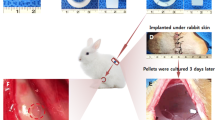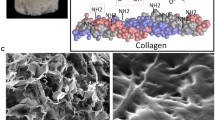Abstract
Functional organ or tissue failure is one of the most frequent, devastating and costly problems in modern health care. The field of tissue engineering has tremendous potential for developing new functional tissue. In reconstructive surgery, cartilage engineering could be a serious alternative to the established method of autologous cartilage transplantation. Recent studies demonstrate cartilage engineering by subcutaneous implantation of chondrocyte-seeded PGA/PLA-fibrin glue scaffolds in the backs of nude mice. In both autologous cartilage transplantation and cartilage engineering, the host immune response affects transplant integrity and cartilage morphology to an unforeseeable extent. To investigate whether polyelectrolyte complex (PEC) membranes can prevent rejection of cartilage transplants without neglecting tissue metabolism, tissue-engineered cartilage encapsulated with a PEC membrane was subcutaneously implanted in the backs of nude mice. Non-encapsulated tissue-engineered cartilage was used for the control group. Histochemistry and scanning electron microscopy were performed 4 and 12 weeks after implantation. There was no interaction between the host and the implant with an intact PEC membrane. With protection by PEC encapsulation, implanted tissue-engineered cartilage showed no signs of degeneration and had a significantly weaker cellular immune response than without it. Thus, PEC membrane encapsulation appears to be a novel approach for protecting cartilage implants from host immune response after autologous transplantation.






Similar content being viewed by others
Abbreviations
- FCS:
-
fetal calf serum
- IL-1:
-
interleukin-1
- NaCs:
-
sodium cellulose sulfate
- NO:
-
nitrogen monoxide
- PEC:
-
polyelectrolyte complex
- PDADMAC:
-
polydiallyl dimethyl ammonium chloride
- PGA/PLA:
-
polyglycolic acid/ polylactide acid
- PGE 2:
-
prostaglandin E 2
- TNF-α:
-
tumor necrosis factor-α
References
Adlington P, Anscombe AJ, Phillips JJ (1992) Influence of the mode of preparation on the long-term efficacy of homologous costal cartilage implants. J Laryngol Otol 106:511–517
Britt JC, Park SS (1998) Autogenous tissue-engineered cartilage. Arch Otolaryngol Head Neck Surg 124:671–677
Bujia, J, Alsalameh A, Sittinger M, Hammer C, Wilmes E, Burmester G (1994) Humoral immune response against minor collagens type IX and XI in patients with cartilage graft resorption after reconstructive surgery. Ann Rheum Diseases 53:229–234
Cao, Y, Vacanti JP, Paige K, Upton J, Vacanti CA (1997) Transplantation of chondrocytes utilizing a polymer-cell construct to produce tissue-engineered cartilage in the shape of a human ear. Plast Reconstr Surg 100:297–304
Dautzenberg H, Arnold G, Tiersch B, Lukanoff B, Eckert U (1996) Polyelectrolyte complex formation at the interface of solutions. Prog Colloid Polymer Sci 101:149–156
Dautzenberg, H, Schuldt U, Grasnick,G (1999) Development of cellulose sulphate-based polyelectrolyte complex microcapsules for medical applications. Ann New York Acad Sci 875:46–63
Grande DA, Halberstadt C, Naughton G, Schwartz R, Manji R (1997) Evaluation of matrix scaffolds for tissue engineering of articular cartilage grafts. J Biom Mat Res 34:211–220
Haisch A, Schultz O, Perka G, Jahnke V, Burmester GR, Sittinger M (1996) Tissue engineering of human cartilage for reconstructive surgery using biocompatible, resorbable fibrin glue with polymer structures. HNO 44:624–629
Haisch A, Rathert T, Jahnke V, Burmester GR, Sittinger M (1998) Practical aspects in cartilage tissue engineering for reconstructive surgery of the auricle. Face 6:107–113
Haisch A, Groeger A, Radtke C, Ebmeyer J, Sudhoff H, Grasnick G, Jahnke V, Burmester GR, Sittinger M (2000) Macroencapsulation of human cartilage implants: pilot study with polyelectrolyte complex membrane encapsulation. Biomaterials 21:1561–1566
Haisch A, Klaring S, Gröger A, Gebert C, Sittinger M (2002) A tissue-engineering model for the manufacture of auricular-shaped cartilage implants. Eur Arch Otorhinolaryngol. 259:316–321
Haisch A, Wanjura F, Radke C, Leder-Johrens K, Groger A, Endres M, Klaering S, Loch A, Sittinger M (2003) Immunomodulation of tissue-engineered transplants: in vivo bone generation from methylprednisolone-stimulated chondrocytes. Eur Arch Otorhinolaryngol Jul 25 [E-pub ahead of print]
Kaps C, Bramlage C, Smolian H, Haisch A, Ungethum U, Burmester GR, Sittinger M, Gross G, Haupl T (2002) Bone morphogenetic proteins promote cartilage differentiation and protect engineered artificial cartilage from fibroblast invasion and destruction. Arthritis Rheum 46:149–162
Kim, B, Mooney D (1998) Development of biocompatible synthetic extracellular matrices for tissue engineering. Tibtech 16:224–230
Langer R (1997) Tissue engineering: a new field and its challenges. Pharm Res 14:840–841
Miyamoto S, Takaoka K, Okada T (1992) Evaluation of polylactid acid homopolymers as carriers for bone morphogenetic protein. Clin Orthop 278:274–285
Naumann A, Bujia J, Hammer C, Wilmes E (1994) Autoantibodies against cartilage components: clinical relevance for head and neck surgery. Laryngol Rhinol Otol 73:253–257
Otte P (1991) Basic cell metabolism of articular cartilage. Manometric studies. Z Rheumatol 50:304–312
Rotter N, Aigner J, Naumann A (1998) Cartilage reconstruction in head and neck surgery: comparison of resorbable polymer scaffolds for tissue engineering of human septal cartilage. J Biomed Mater Res 42:347–356
Sittinger M, Lukanoff B, Burmester GR, Dautzenberg H (1996) Encapsulation of artificial tissues in polyelectrolyte complexes. Biomaterials 17:1049–1051
Sittinger MJ, Braunling E, Kastenbauer C, Hammer G, Burmester J, Bujia (1997) Proliferative potential of nasal septum chondrocytes for in vitro culture of cartilage transplants. Laryngol Rhinol Otol 76:96–100
Stoll W (1997) Complications following implantation or transplantation in rhinoplasty. Facial Plast Surg 13:45–50
van Schilfgaarde R, de Vos P (1998) Factors in success and failure of microencapsulated pancreatic islets. Transpl Proc 30:501–502
Villinger P (1998) Zytokine und rheumatic diseases. Huber, Bern, Göttingen, Toronto, Seattle, pp 72–77
Weber C, Tanna A, Costanzo M, Ayres-Price J, Peterson L, Wicker L (1994) Effects of host genetic background and microencapsulation on survival of rat-to-mouse islet xenografts. Transpl Proc 26:1186–1189
Weiss L (1983) Specialized connective tissue. In: Weiss L (ed) Cartilage and bone. Histology, cell and tissue biology, vol 4. Elsevier Biomedical, New York, Amsterdam, Oxford, pp 137–149
Acknowledgements
This study was supported in part by funding of the University Hospital Charité and the German Research Foundation (DFG, Ha 2729/1-2).
Author information
Authors and Affiliations
Corresponding author
Rights and permissions
About this article
Cite this article
Haisch, A., Gröger, A., Gebert, C. et al. Creating artificial perichondrium by polymer complex membrane macroencapsulation: immune protection and stabilization of subcutaneously transplanted tissue-engineered cartilage. Eur Arch Otorhinolaryngol 262, 338–344 (2005). https://doi.org/10.1007/s00405-004-0783-3
Received:
Accepted:
Published:
Issue Date:
DOI: https://doi.org/10.1007/s00405-004-0783-3




